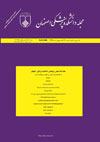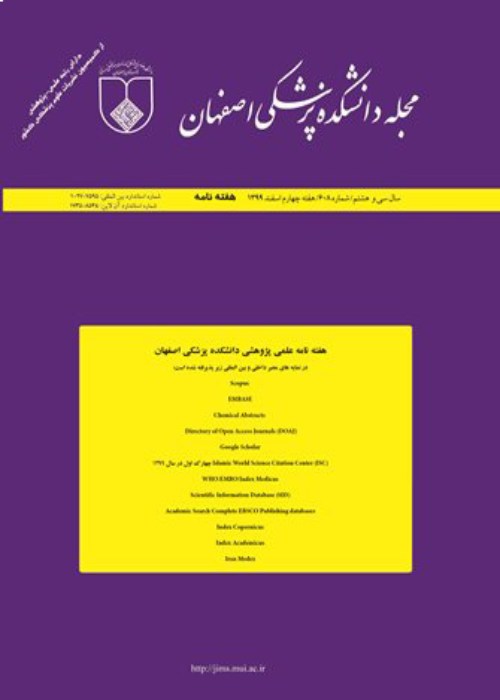فهرست مطالب

مجله دانشکده پزشکی اصفهان
پیاپی 627 (هفته سوم امرداد 1400)
- تاریخ انتشار: 1400/05/23
- تعداد عناوین: 3
-
-
صفحات 384-389
مقدمه :
همشیرهای کودکان مبتلا اختلال طیف اوتیسم (Autism spectrum disorder یا ASD) ممکن است با اختلال در نمو رفتاری- اجتماعی مواجه باشند؛ این مساله، همچنان با پاسخ های متناقضی همراه است. مطالعه ی حاضر با هدف ارزیابی اختلالات رفتاری- اجتماعی در همشیرهای کودکان ASD انجام شد.
روش هااین مطالعه ی توصیفی- تحلیلی- مقطعی، بر روی 51 همشیر کودکان مبتلا به اوتیسم و 138 کودک بدون همشیر مبتلا به اوتیسم در دانشگاه علوم پزشکی اصفهان در سال های 98-1397 انجام گرفت. نمو اجتماعی با استفاده از مقیاس پاسخ دهی اجتماعی (Social responsiveness scale یا SRS) و نمو رفتاری با استفاده از پرسش نامه ی توانایی ها و مشکلات (Strengths and difficulties questionnaire یا SDQ) ارزیابی و در دو گروه مقایسه شد.
یافته هامیانگین سنی کودکان در گروه مورد برابر با 28/2 ± 61/9 سال و در گروه شاهد 10/1 ± 31/8 سال بود (087/0 = P). 28 نفر (9/54 درصد) از گروه مورد و 65 نفر (1/47 درصد) از گروه شاهد مذکر بودند (140/0 = P). میانگین نمره ی کسب شده از SRS در گروه مورد و شاهد به ترتیب برابر با 84/36 ± 35/43 و 20/11 ± 69/29 به دست آمد (020/0 = P). یافته های پرسش نامه ی SDQ نیز حاکی از نمره ی 53/5 ± 93/5 در گروه مورد و نمره ی 57/2 ± 26/3 در گروه شاهد بود (020/0 = P).
نتیجه گیریبر طبق یافته های این مطالعه، همشیرهای کودکان مبتلا به اوتیسم در قیاس با همشیرهای بدون سابقه ی اوتیسم، اختلالات اجتماعی و رفتاری بیشتری را بروز می دهند.
کلیدواژگان: اختلالات اوتیستیک، طیف اختلال اوتیسم، همشیرها، تغییرات اجتماعی، مشکلات رفتاری -
صفحات 390-399
مقدمه:
رفتارهای پرخطر، یکی از مهم ترین چالش های بهداشتی و روانی- اجتماعی است که بیشتر کشورهای جهان به نوعی با آن درگیر هستند. هدف از انجام این مطالعه، ارزیابی ویژگی های روان سنجی پرسش نامه ی ارزیابی رفتارهای پرخطر جوانان (Youth risk behavior survey Questionnaires 2019 یا YRBS 2019) برای جمعیت جوانان ایرانی بود.
روش هاپژوهش حاضر یک مطالعه ی توصیفی- تحلیلی و از نوع مقطعی بود که جامعه ی آماری آن را دانشجویان سال تحصیلی 400-1399 در شهر مشهد تشکیل می دادند. شرکت کنندگان 400 دانشجوی واجد شرایط ورود به مطالعه بودند که به شیوه ی تصادفی طبقه ای انتخاب شدند. پس از ترجمه ی پرسش نامه با استفاده از روش ترجمه- باز ترجمه، روایی محتوا با استفاده از ضریب نسبی روایی محتوا (Content validity ratio یا CVR) و شاخص روایی محتوا (Content validity index یا CVI)، روایی سازه با استفاده از تحلیل عاملی، پایایی با استفاده از ضریب همبستگی درون خوشه ای و سازگاری درونی با استفاده از Cronbach's alpha ارزیابی گردید.
یافته هامیانگین سنی دانشجویان 36/2 ± 54/23 سال بود. شاخص های مربوط به روایی محتوایی و صوری 40 گویه مورد تایید قرار گرفت. تحلیل عاملی تاییدی ساختار 6 عامل و مجموع 25 سوال را مورد تایید قرار داد. مقدار Cronbach's alpha در کلیه ی حیطه ها در مجموع بیشتر از 7/0 مورد تایید قرار گرفت. ضریب همبستگی درون خوشه ای (007/0 = P، 735/0 = Intraclass correlation coefficient یا ICC) بود که بیانگر پایا بودن پرسش نامه است.
نتیجه گیریپرسش نامه ی فرم کوتاه ارزیابی رفتارهای پرخطر جوانان، ویژگی های روان سنجی لازم را دارد. در این پژوهش، 6 عامل استخراج شده در پرسش نامه (YRBS) با عوامل استخراج شده در نسخه ی اصلی منطبق بود. بنابراین، پیشنهاد می شود از این ابزار برای تشخیص رفتارهای پرخطر در جوانان استفاده شود.
کلیدواژگان: تکرارپذیری نتایج، رفتارهای پرخطر، جوانان، مطالعات و پرسشنامه ها، ارزیابی متغیرهای روانی -
صفحات 400-407
مقدمه:
Streptococcus agalactiae (استرپتوکوکوس گروه B یا GBS)، ساکن طبیعی دستگاه گوارش و ادراری- تناسلی افراد سالم است و به عنوان شایع ترین علت سپسیس، مننژیت، پنومونی و بیماری های شدید در نوزادان تازه متولد شده است. مقاومت به پنی سیلین و ماکرولیدها به عنوان آنتی بیوتیک های انتخابی درمان عفونت های GBS رو به افزایش است. مطالعه ی حاضر با هدف تعیین سروتیپ های کپسولی و مقاومت آنتی بیوتیکی جدایه های Streptococcus agalactiae در زنان باردار مراجعه کننده به بیمارستان ولیعصر (عج) شهرستان بروجن انجام شد.
روش ها:
این مطالعه ی توصیفی- مقطعی بر روی 760 نمونه ی سواپ واژینال خانم های باردار (هفته های 37-35 بارداری) انجام شد. باکتری های جدا شده با روش های فنوتیپی شناسایی و بعد از تایید GBS، مقاومت آنتی بیوتیکی جدایه های GBS </em>نسبت به دیسک های آنتی بیوتیکی به روش دیسک دیفیوژن انجام و سپس، سروتیپ های کپسولی جدایه ها به روش Multiplex polymerase chain reaction (Multiplex PCR) تعیین شد.
یافته ها:
از 760 زن باردار شرکت کننده در این مطالعه، 70 نفر (2/9 درصد) حامل GBS بودند. بیشترین مقاومت جدایه ها مربوط به تتراسیکلین (85/92 درصد) و کمترین مقاومت نسبت به پنی سیلین (0) بود. فراوان ترین سروتیپ کپسولی سروتیپ III (71/45 درصد)، سپس سروتیپ های II (14/17 درصد)، VI (28/14 درصد)، Ib (42/11 درصد)، V (57/8 درصد) و Ia (85/2 درصد) بود.
نتیجه گیریشیوع این باکتری و میزان مقاومت آنتی بیوتیکی نسبت به ماکرولیدها در این مطالعه پایین و همانند سایر مطالعات سروتیپ کپسولی III غالب بود
کلیدواژگان: galactiae Streptococcus، مقاومت آنتیبیوتیکی، زنان باردار، سروتایپینگ، استرپ گروه B
-
Pages 384-389Background
The siblings of children with autism disorder spectrum (ASD) may struggle socio-behavioral development disorders; however, the issue has remained controversial. The current study aimed to assess socio-behavioral disorders among the siblings of the children with ASD.
MethodsThis cross-sectional study was conducted on 51 siblings of children with autism and 138 siblings of children without autism in Isfahan University of Medical Sciences (Isfahan, Iran) during the years 2019-20. Social development was assessed using Social Responsiveness Scale (SRS) and behavioral development using Strengths and Difficulties Questionnaire (SDQ); the findings were compared between the two groups.
FindingsThe mean age was 9.61 ± 2.28 and 8.31 ± 1.10 years in case and control groups, respectively (P = 0.087). 28 cases (54.9%) and 65 controls (47.1%) were boys (P = 0.140). Mean SRS score was 43.35 ± 36.84 and 29.69 ± 11.20 in case and control groups, respectively (P = 0.020). Outcomes of SDQ revealed scores of 5.93 ± 5.53 and 3.26 ± 2.57 in case and control groups, respectively (P = 0.020).
ConclusionBased on the outcomes of this study, siblings of children with autism are involved with more socio-behavioral disorders as compared to the control group.
Keywords: Autistic disorder, Autism spectrum disorder, Siblings, Social change, Problem behavior -
Pages 390-399Background
High-risk behaviors are of the most important health and psychological and social challenges that most countries in the world are involved with in some way. The purpose of this study was to evaluate the psychometric properties of the Youth Risk Behavior Assessment Questionnaire (YRBS 2019) for the Iranian youth population.
MethodsThis was a descriptive-analytical cross-sectional study in which the statistical population consisted of university students in Mashhad City, Iran, in the academic year of 2020-2021. Participants were 400 eligible students who were selected using stratified random sampling method. After translating the questionnaire using translation-retranslation method, content validity was assessed using relative content validity coefficient (CVR) and content validity index (CVI), construct validity using factor analysis, reliability using intra-cluster correlation coefficient, and internal consistency was assessed using Cronbach's alpha.
FindingsThe mean age of students was 23.54 ± 2.36 years. Indices related to content and face validity of 40 items were confirmed. Confirmatory factor analysis confirmed the structure of 6 factors, and the total of 25 questions. Cronbach's alpha value was confirmed in all domains and in total, more than 0.7 for all. The intra-cluster correlation coefficient (ICC) was 0.735 (P = 0.007) which indicated the reliability of the questionnaire.
ConclusionThe YRBS short form questionnaire had the necessary psychometric properties for assessing high-risk behaviors of young people. In this study, 6 factors extracted in YRBS questionnaire were consistent with the factors extracted in the original version; therefore, it is suggested to use this tool to detect high-risk behaviors in young people.
Keywords: Reproducibility of results, Dangerous behaviors, Youth, Surveys, questionnaires, Psychometrics -
Pages 400-407Background
Streptococcus agalactiae (Group B Streptococcus or GBS) is a natural resident of the gastrointestinal tract of healthy individuals, and is the most common cause of sepsis, meningitis, pneumonia, and severe diseases in newborns. Resistance to penicillin and macrolides, as selective antibiotics for the treatment of GBS infections, is increasing. In this study, we aimed to determine the capsule serotypes and antibiotic resistance pattern of Streptococcus agalactiae isolated from pregnant women referred to the Valiasr hospital in Borujen City, Iran.
MethodsIn this descriptive cross-sectional study, a total of 760 vaginal samples were collected from pregnant women in the period between 35-37 weeks of gestation. Following conventional phenotypic evaluation and GBS confirmation, GBS isolates resistance to antibiotic disc was assessed through disk diffusion test. Finally, capsular serotypes were determined using multiplex polymerase chain reaction (multiplex PCR) method.
FindingsOut of 760 pregnant women participating in this study, 70 (9.2%) were carriers of GBS. Our finding disclosed that the lowest and highest resistance among GBS isolates were related to penicillin (0%), and tetracycline (92.85%), respectively. The most common capsular serotypes were III (45.71%), followed by II (17.14%), VI (14.28%), Ib (11.42%), V (8.57%), and Ia (2.85%), respectively.
ConclusionIn this study, we detected low prevalence of GBS, as well as low level resistance to macrolides. In addition, predominant capsular serotype was III.
Keywords: Streptococcus agalactiae, Antibiotic resistance, Pregnant women, Serotyping, Streptococcus group B


